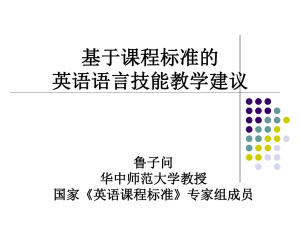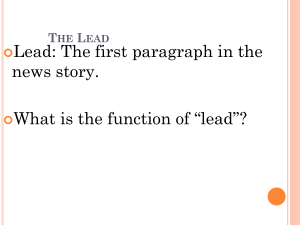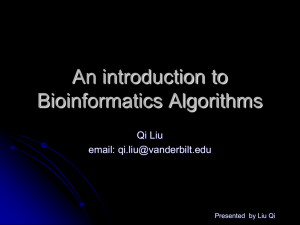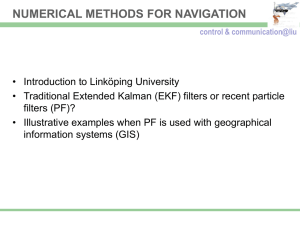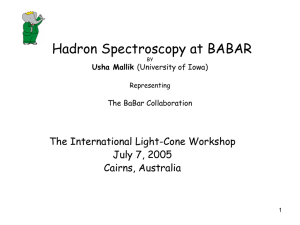新强子态唯象理论进展 - ihep.ac.cn
advertisement
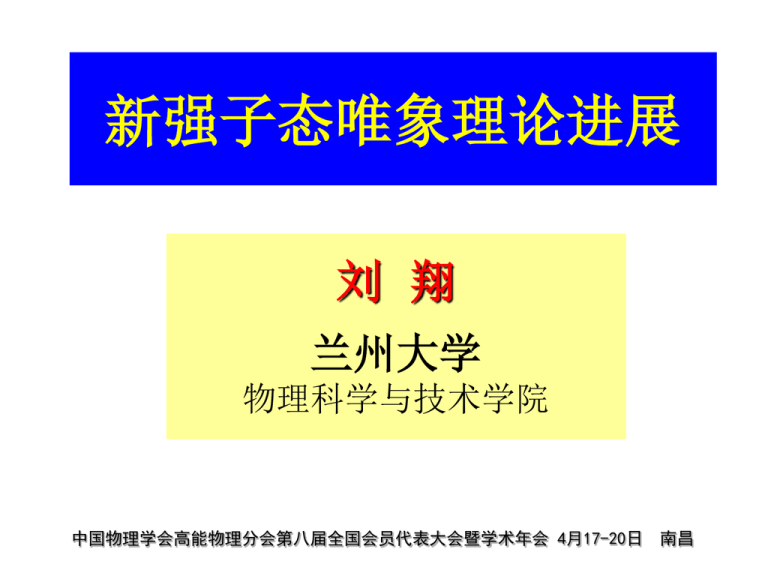
新强子态唯象理论进展 刘 翔 兰州大学 物理科学与技术学院 中国物理学会高能物理分会第八届全国会员代表大会暨学术年会 4月17-20日 南昌 Outline • Charmonium-like state X(3872), [Z(4430),Z(4051),Z(4248)], [Y(3930),Y(4140)] [X(3915), Z(3930),X(4350)] • Charmed-strange state DsJ(2710), DsJ(2860), DsJ(3040) • Bottom-strange state Bs1(5830), Bs2(5840) • Y(2175)-Y(4260)-Y(10870) • Summary Charmonium-like state X X PRL91, 262001 (2003) X(3872) observation PRD71, 071103 (2005) PRD73, 011101 (2006) 10s B factories in B decays X(3872) first seen in B →K J/π+π– PRL98, 132002 (2007) CDF 790fb-1: X→J/ π+π– angular analysis only JPC=1++ and JPC = 2–+ M(J/π+π–) PRL93, 072001 (2004) 1 PRL93, 162002 (2004) 新强子态唯象理论进展 • MX close to D0D*0 threshold (not clear below or above) M = 3871.4±0.6 MeV MX – MDD* = (–0.40.7) MeV/c2 • surprisingly narrow: Γtot < 2.3 MeV at 90% CL • M(ππ) tends to kinematic limit ππ=? Isospin violation! 刘翔 @ 兰州大学 Explanations to X(3872) conventional charmonium JPC=1++ corresponds to c1(23P1) expected Γ(c1′J/)/ Γ(c1′J/ ) ~30 measured ratio < 0.2 ~ 100MeV/c2 lighter than expected. 3872 D0D*0 molecular state: (the most popular option) E.S.Swanson, F.E.Close and P.R. Page, M.B.Voloshin... ─ Tetraquark (cq)(cq): u c Xu = c u L.Maiani, A.D.Polosa, V.Riquer, F.Piccini; D.Ebert, R.N.Faustov, V.O.Galkin ─ (cd)(cd) ─ (cd)(cu), ─ with a few MeV 3 states (cu)(cu), mass splitting d c Xd = Hybrid (ccg) F.E.Close and P.R. Page Threshold cusp D.V.Bugg 2 c d B 0 X(3872)– M(J/π–π0) PRD71,031501 (2005) B- X(3872)– M(J/π–π0) NO evidence of X–(3872) J/–0 excludes isovector hypothesis 新强子态唯象理论进展 刘翔 @ 兰州大学 X(3872)→J/ψπ+π– PRD77, 111101 (2008) B+→XK+ 8.6σ 2.3σ B0→XK0s BELLE-CONF-0849 Experimental evidence against the molecular assignment B+→XK+ 12.8s PRL102,132001 (2009) B0→XK0s 5.9s Relatively large Br(X→(2S)γ) is ─ 0 *0 inconsistent with a pure D D molecular interpretation for X(3872) Swanson, PLB598, 197 (2004) Br(B0→XK0) / Br(B+→XK+) = 0.41 ± 0.24 ± 0.05 0.82 ± 0.22 ± 0.05 Molecular state: the theoretical prediction is less than 0.1 Br(B0→XK0) Br(J/–+) = (6.65 ± 1.63 ± 1.00)x10–6 3 新强子态唯象理论进展 刘翔 @ 兰州大学 • Reexamine the X(3872) by potential model • Disfavor the molecular explanation if only considering one pion exchange • If including vector meson exchange, there exist the possibility of DD^* molecular state assignment for X(3872). Dynamics calculation Liu, Liu, Deng, Zhu, EPJC56, 63 (2008) Liu, Luo, Liu, Zhu, EPJC61, 411 (2009) • However it is dependent on the parameter space. What is the structure of X(3872)? X (3872) : a dominant cc component with some admixture of D0 D*0 D0 D*0 Suzuki, PRD72, 114013 Meng, Chao, arXiv:hep-ph/0506222 Zhu, IJMP, E17, 283 Liu, Liu, Deng, Zhu, EPJC56, 63 Mixing mechanism =Coupled channel effect D cc 4 π c cc D* 新强子态唯象理论进展 c u u 刘翔 @ 兰州大学 Z(4430)- Z(4051)- Z(4248)charged charmonium-like state If this result is confirmed first observation of a genuine ccud “exotic” state, since it is charged and carries hidden charm. PRL100, 142001 (2008) PRD78, 072004 (2008) Z(4430) Z(4051) Z(4248) B→Z-K Z-→ψ(2S)π- 6.5σ +1830 M=4433 4 2 MeV =45-13 13 MeV arXiv:0810.1073 [hep-ex] No significant Z(4430) signal is observed 5 新强子态唯象理论进展 刘翔 @ 兰州大学 Explanations for Z(4430) Liu, Liu, Deng, Zhu, PRD77, 034003 (2008) PRD77, 094015 (2008) Rosner S-wave threshold effect of D1(2420)-D*(2010) Dynamics calculation: (Meng, Chao), Ding D1(2420)D*(2010) molecule D1' (2430) with broad width S-wave D1D* system (Maiania, Polosa, Riquerd) and (Gershtein, Likhoded, Pronko) Tetraquark state Cheuanga, Keung, Yuan Bottom analog of Z(4430) assuming it is a tetraquark bound state Lee, Mihara, Navarra, Nielsen S wave D1' D* system QSR D1(2420)D*(2010) Bugg Cusp effect (Braatten, Lu) Studying the Line shape of Z(4430) Li, Lv, Wang Partners of Z(4430) and Productions in B Decays 6 only J P 0 B1' B* system B1B* system Tevatron and LHCb __ Z(4051) disfavor a D*D* molecular state? Liu, Luo, Liu, Zhu, EPJC61, 411 (2009) Liu, Zhang, PRC80, 015208 (2009) Z(4248): disfavor D1 D or D0 D* molecular state! Qiao Liu, Zhao, Close J P 0 ,1 , 2 The photoproduction of Z(4430) Ding, PRD79, 014001 (2009) 新强子态唯象理论进展 刘翔 @ 兰州大学 Phys.Rev.Lett.94:182002 (2005) The similarities between Y(4140) and Y(3930): Y(3930) Both Y(4140) and Y(3930) were observed in the mass spectrum of J/ +light vector meson Phys.Rev.Lett.102:242002,2009 M 3943 11(stat ) 13( syst ) MeV =87 22(stat) 26(syst) MeV J/ Y (4140) B K+ J/ Y (3930) The mass difference between Phys.Rev.Lett.101: 082001 (2008) Y(4140) Y(3930) Y(4140) and Y(3930) approximately equal to that between and M Y(4140) M Y (3930) M M Y(4140) and Y(3930) are close to the thresholds of D*s D*s and D* D* , and satisfy an almost M 4143.0 2.9 1.2 MeV +8.3 =11.7-5.0 3.7 MeV C parity: + 7 G parity: + exact mass relation M Y(4140) 2 M D* s M 3914.6 3.8 3.4 ( stat ) 2.0(syst ) MeV M Y (3930) 2 M D* 90 MeV =34-8+12 ( stat ) 5( syst ) MeV 新强子态唯象理论进展 刘翔 @ 兰州大学 Explanation of Y(4140) and Y(3930) Y (4140) is a D*s D*s molecular state Y(3930) is its D*D* molecular partner Liu & Zhu, PRD80, 017502 (2009) Mahajan, PLB679,228 (2009) Branz, Gutsche, Lyubovitskij, PRD80, 054019 (2009) Dynamics calculation: Liu, Luo, Liu, Zhu, EPJC61, 411-428 (2009) Ding, EPJC64, 297-308 (2009) Select Rule The possible quantum numbers of the S-wave vector-vector system are Other interpretations: J 0 ,1 , 2 . P Dynamically generated resonances However for the neutral D*D* system with C=+, we can have J P 0 , 2 Molina, Oset, arXiv:1001.3005 [hep-ph] Tetraquark state Stancu, arXiv:0906.2485 [hep-ph] since C=(-1) L S and J=S with L=0. 8 新强子态唯象理论进展 刘翔 @ 兰州大学 Decay Patterns of Y (4140) and Y (3930) Open charm and hidden charm two-body decays Radiative decays Liu & Ke, PRD80, 034009 (2009) Liang, Molina, Oset, arXiv:0912.4359 [hep-ph] The open-charm decay widths are comparable to the hidden-charm decay width Such a D-wave decay width should be much smaller than that for the above hidden charm S-wave decay mode! S-wave D-wave Liu, PLB680, 137 (2009): exclude P-wave charmonium explanation for Y(4140) 9 新强子态唯象理论进展 刘翔 @ 兰州大学 The charmonium-like states in fusion process Phys.Rev.Lett.96:082003,2006 Phys.Rev.Lett.104:092001,2010 ' c2 Z(3930) X(3915) M 3929 5 2 MeV =29 10 2 MeV M ( J /) GeV Phys.Rev.Lett.104:112004,2010 arXiv:1002.0281 [hep-ex] X(4350) M 4350.6 4.6 5.1 0.7 MeV =13+18 9 4 MeV Z(3930) M 3926.7 2.7 1.1 MeV =21.3 6.8 3.6 MeV 10 新强子态唯象理论进展 刘翔 @ 兰州大学 11 新强子态唯象理论进展 刘翔 @ 兰州大学 Charmed-strange state Phys.Rev.Lett.97:222001,2006 Phys.Rev.Lett.100:092001,2008 J P 1 DsJ (2860) DsJ (2710) Phys.Rev.D80:092003,2009 DsJ(2710) hep-ex/0608031 Belle DsJ(2860) DsJ(3040) 12 新强子态唯象理论进展 刘翔 @ 兰州大学 Explanations of DsJ (2710) cs : Mixing of | 23 S1 and |13 D1 Close, Thomas, Lakhina, Swanson, PLB647, 159 (2007) Li, Ma, Liu, EPJC51, 359 (2009) Regge phenomenology Zhong, Zhao, PRD81, 014031 (2010) Constituent quark model Li, Ma, PRDD81, 014021 (2010) QPC cs (23 S1 ) : The first radial excitation of 1- c s state Zhang, Liu, Zhu, EPJC50, 617 (2007) Obtained ratio of D*K/DK is consistent with experimental data. QPC Matsuki, Morii, Sudoh, EPJA31, 701 (2007) Colangelo, De Fazio, Nicotri, Rizzi, PRD77, 014012 (2008) D* K / DK 0.91 23 S1 D* K / DK = 0.043 13 D1 Phys.Rev.D80:092003,2009 Chen, Wang, Zhang, PRD80, 071502 (2009) Wang, Zhang, Wang, PLB681, 326 (2009) B decay+BS equation cs : 13 D1 Zhang, Liu, Zhu, EPJC50, 617 (2007) QPC Wei, Liu, Zhu, PRD75, 014013 (2007) D-wave cs Shan, Zhang, arXiv:0805.4764, arXiv:0904.2453 QSR Mass loaded flux tube model Mutiquark 1D assignment to DsJ(2710) can be excluded. Vijande, Valcarce, Fernandez, PRD79, 037501 (2009) 13 新强子态唯象理论进展 刘翔 @ 兰州大学 Explanations of DsJ (2860) The first radial excitation of the D*s0 (2317): J p 0 van Beveren, Rupp, PRL97, 202001 (2006) RSE model Close, Thomas, Lakhina, Swanson, PLB647, 159 (2007) Zhang, Liu, Zhu, EPJC50, 617 (2007) QPC Matsuki, Morii, Sudoh, EPJA31, 701 (2007) It can be fully excluded since DsJ(2860)->D*K channel was observed ar BaBar cs : |13 D3 J p 3 Zhang, Liu, Zhu, EPJC50, 617 (2007) QPC Colangelo, De Fazio, Nicotri, PLB642, 48 (2006) Effective Lagrangian Li, Ma, Liu, EPJC51, 359 (2009) Regge phenomenology Zhong, Zhao, PRD81, 014029 (2010) Constituent quark model Shan, Zhang, arXiv:0805.4764, arXiv:0904.2453 Chen, Wang, Zhang, PRD80, 071502 (2009) Mass loaded flux tube model Li, Ma, PRDD81, 014021 (2010) QPC D*K/DK=0.8 Mutiquark Vijande, Valcarce, Fernandez, PRD79, 037501 (2009) Two Overlapping resonances ( radially excited 0+ and 2+ cs states) at 2.86 GeV van Beveren, Rupp, arXiv:0908.1142 [hep-ph] Mixture of charmed-strang states Zhong, Zhao PRD81, 014031 (2010) Li, Ma, PRDD81, 014021 (2010) J P 1 : Mixing of | 23 S1 and |13 D1 D*K/DK=0.36, which is smaller than experimental value Babar data Phys.Rev.D80:092003,2009 Ratio of D*K/DK consistent with experimental data DsJ (2710) 14 新强子态唯象理论进展 刘翔 @ 兰州大学 2P cs state assignment to DsJ (3040) 2S state DsJ(2710): 1- D* K DK Sun, Liu, PRD80, 074037 J P 1 ,0 , 2 ,... 1D state DsJ(2860) Matsuki, Morii, Sudoh, EPJA31, 701 (2007) DsJ (3040) is the first radial excitation of DsJ (2460) Chen, Wang, Zhang, PRD80, 071502 (2009) A semi-classic flux tube model 15 Zhong, Zhao, PRD81, 014031 (2009) Constituent quark model with effective Lagrangian Colangelo, Fazio, arXiv:1001.1089 [hep-ph] Effective Lagrangian approach 新强子态唯象理论进展 刘翔 @ 兰州大学 Bottom-strange state The situation of bottom-strange meson is similar to that of charmed-strange meson before 2003 Phys.Rev.Lett.100:082001,2008 Strong decay Luo, Chen, Liu, PRD79, 074020 (2009) CDF [23] Godfrey, Kokoski, PRD43, 1679 (1991) [24] Eichten, Hill, Quigg, PRL71, 4116 (1993) [27] Falk, Mehen, PRD53, 231 (1996) [29] Colangelo, De Fazio, Ferrandes, NPB. proc. Suppl.163, 177 (2007) [31] Zhong, Zhao, PRD78, 014029 (2008) Phys.Rev.Lett.100:082002,2008 D0 m 5839.6 1.1(stat ) 0.7(syst ) MeV 16 Semileptonic decay 新强子态唯象理论进展 Luo, Chen, Liu, Zhu, EPJC60, 403 (2009) 刘翔 @ 兰州大学 Y(2175)-Y(4260)-Y(10870) PRD74, 091103 (2006) PRL100, 102003 (2008) PRD80, 031101 (2009) BES [1] BaBar, PRD74, 091103 (2006) [2] BES, PRL100, 102003 (2008) [3] BELLE, PRD80, 031101 (2009) [4] BES, PLB685, 27 (2010) [5] BaBar, PRD77, 092002 (2008) 17 新强子态唯象理论进展 Y(2175) 刘翔 @ 兰州大学 Y(4260) J / PRL 99, 182004 (2007) PRL 95,142001(2005) First Y(4260) (2S) 2-BW fit with interference • two solutions: different peak cross sections Y(4008) 7.4σ 8σ 233 fb-1 PRD74,091104R(2006) 5.4σ 18 Y(4260) 550 fb-1 ed m r i f Con PRL 96,162003(2006) 11σ + J/00 (5.1σ) 13.3 fb-1 新强子态唯象理论进展 刘翔 @ 兰州大学 Y(10870) (nS ) Phys.Rev.Lett.100:112001,2008 The measured width of Y(10870) (1S,2S) is 2 : 3 order larger than those of (nS) (mS) (n=2,3,4 and m<n) Energy scan above Υ(4S) to search for counterpart of Y(4260) in bottomonium sector: study cross section of e+e → Υ(nS)π+π, (n=1, 2, 3) New bottomoniumlike state or anoumalous large Υ(5S) → Υ(nS)ππ decay Υ(5S) : m=10.865 GeV Г=110 MeV arXiv:0810.3829 19 新强子态唯象理论进展 刘翔 @ 兰州大学 Y(2175) Strange Y(4260) Charm J / Y(10870) Bottom (nS ) Hybrid ccg ss (23 D1 ) Ding, Yan, PLB657, 49 Hybrid ssg Ding, Yan, PLB650, 390 Three-body system KK Zhu, PLB625, 212 Kou, Pene, PLB631, 164 Close, Page, PLB628, 215 Three-body system J/ KK Torres et al., PRD80, 094012 Torres et al., prd78, 074031 bound state c c bound state Qiao, PLB639, 263 Klempt, Zaitsev, PR451, 1 Tetraquark [cs][cs] Tetraquark ssss Maiani et al. PRD72, 031502 Wang, NPA791, 106 Molecular state Chen, Liu, Liu, Zhu Liu, Zheng, Li, PRD72, 054023 PRD78, 034012 Yuan et al., PLB634, 399 20 新强子态唯象理论进展 (5S) + FSI Meng, Chao, PRD77, 074003 PRD, 78, 034002, PRD78, 074001 Hybrid bbg Olsen, arXiv:0801.1153 Godfrey, Olsen, ARNPS58, 51 b b bound state? Tetraquark [bs][b s] Ali et al. arXiv:0912.5016 PLB684, 28 刘翔 @ 兰州大学 Summary Charmonium-like state X, Y, Z Distinguish the conventional charmonium state and exotic states Above the thresholds of a pair of charmed mesons Important non-perturbative effect Coupled-channel effect Mass spectrum + Production + Decay More experimental information is needed Charmed-strange meson DsJ(3040) 2P state (1+ state in S doublet) Four states DsJ(2860)+DsJ(2710) ----- 2S and 1D states Six states The experimental search for charmed-strange meson with high radial excitation 21 新强子态唯象理论进展 刘翔 @ 兰州大学 Bottom-strange meson Bs1(5930)+Bs2(5940) 2P states in T doublet (1+,2+) Two 2P states in S doublet (0+, 2+) are missing Nowadays, the situation of bottom-strange meson family is very similar to that of charmed-strange meson family before 2003 Future experiments LHCb? Y(2175) Y(4260) Y(10870) Similar decay channel phi pi pi J/psi pi pi Upsilon(nS) pi pi Similar theoretical explanation Hybrid Mutiquark state Molecular state Distinguish different theoretical assignments Y(2175) BESIII Y(4260) Exotic state? Other mechanisms? Y(10870) Upsilon(5S)? 22 exotic state? 新强子态唯象理论进展 刘翔 @ 兰州大学 New hadron state: an active research field in hadron physics BESIII 2003 Y(4260) DsJ(2317) DsJ(2460) X(1860) 2010 Charmonium-like states X, Y, Z Charmed-strange meson DsJ Bottom-strange meson BsJ Light hadrons X(1860), X(1835), Y(2175) …… Super B PANDA LHCb + …… More efforts: theoretical work + experiment 23 新强子态唯象理论进展 刘翔 @ 兰州大学 Thank you for your attention! Backup slides 2 新强子态 刘翔 @ 兰州大学 The low mass puzzle of DsJ (2317) and DsJ (2460) Phys.Rev.Lett.90:242001,2003 Experimental masses are 100 MeV lower than the expected values in quark models DsJ(2317) S. Godfrey and R. Kokoski, PRD 43, 1679 (1991); S. Godfrey and N. Isgur, PRD 32, 189 (1985); M. Di Pierro and E. Eichten, PRD 64, 114004 (2001) Four-quark state? Barnes, Close, Lipkin PRD68, 054006 (2003) Cheng, Hou, PLB566, 193 (2003) Chen, Li, PRL93, 232001 (2004) Coupled-channel effect plays an important role to understand the low mass puzzle Phys.Rev.D68:032002,2003 DsJ(2460) van Beveren, Rupp, PRL91, 012003 (2003) EPJC32, 493 (2004) Dai, Li, Zhu, Zuo, EPJC55, 249 (2008) Liu,Liu,Zhu PRD79, 094026 (2009) Charmed-strange C RSE QSR CHPT S Godfrey, PLB568, 254 (2003) Colangelo, De Fazio, PLB570, 180 (2003). Dai, Huang, Liu, Zhu, PRD68, 114011 (2003) 13 新强子态唯象理论进展 刘翔 @ 兰州大学 arXiv:0808.1543 Y(4260) e+e–→J/ψπ+π– γISR Y(4260) ... Y(4008)? Y(4008) Br(J/ψπ+π–)Γee , eV Solution1 Y(4008) Solution2 < 0.7 90% CL Solution1 Y(4260) Solution2 7.5±0.9± 0.8 Absence of open charm production is inconsistent with conventional charmonium 21 新强子态唯象理论进展 刘翔 @ 兰州大学 PRD 78, 014032 (2008) (2007) PRL 98, 212001 Y(4360)→ψ(2S)ππ Y(4360) Y(4660)? Y(4660) 6.1σ Combined fit to + – e e →ψ(2S) BaBar&Belle +π – –γ + π data on e e →(2S) ISR + π– γ πY(4360), ISR 298 fb-1 Y(4660) ... Best measurements of Y(4360) and Y(4660) PRL 99, 142002 (2007) 2-BW fit with interference Assume all the cross sections areY(4660) due to Y(4360) Y(4360) and Y(4660) added coherently 5.8σ 8σ Br(ψ(2S)π+π–)Γee , eV Solution1 Solution2 Y(4360) Y(4660) 670 fb-1 Absence of open charm production is inconsistent with conventional charmonium

